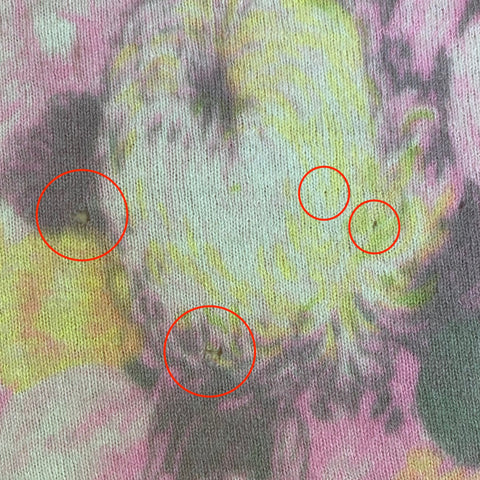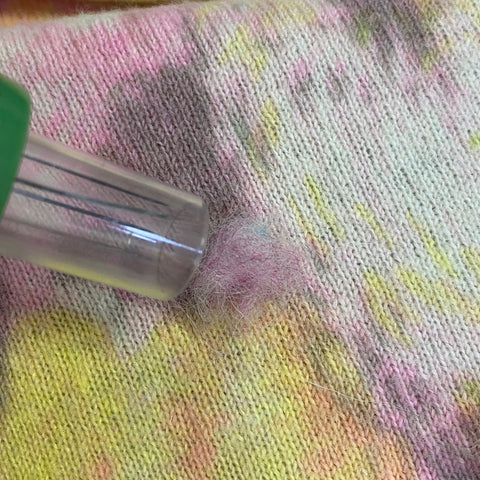Do you ever find yourself tempted to throw out a piece of clothing that's got a tear or hole in it? Well, I recently found myself in that exact predicament. But rather than tossing my favorite sweater into the trash, I decided to try something different and mend it instead. Not only did the process save me money and help the environment, but it also reminded me of how empowering and satisfying mending can be.
My Mending Journey Begins
My sweater had gotten four moth holes over the winter and I was pretty bummed about it. To make matters worse, I couldn't find any patches or materials that matched the pattern of my beloved sweater. So, after much deliberation, I decided to create some visible mends as well as some invisible ones. With some patience and creativity, I was able to mend the sweater and end up with an even better item than before!

Photo: My fave sweater had 4 holes that bummed me out.
Why Mending Matters
More than 15 million tons of clothing are sent to landfills each year in the United States alone. This waste not only contributes to environmental damage but also costs money—in particular, when repairable items like clothes are thrown out without being mended first.
Mending Creates Community
Mending can also bring people together; friends and family can come together to brainstorm ideas on how to mend clothes or other items they own while also enjoying each other's company.
Mending Saves Money
When you choose to mend your clothes rather than replace them, you save money that would have otherwise gone towards buying new items. When you invest time in finding ways to repair or repurpose your clothes, you extend their life expectancy which saves you money in the long run as well as saving resources from being used unnecessarily.
How to Mend: Different Types of Mends
There are two types of mends - visible and invisible. Visible mends are those that involve adding patches or fabric embellishments that make the mend more noticeable (think Dolly Parton’s iconic patchwork dress). You could use a contrasting color on the wrong side to create a new effect.

Photo: Placing the wool roving at the right spots on the sweater.
Invisible mends on the other hand involve repairing holes or tears without making the mend obvious, see the photo. Both types of mends can be done quickly and easily with or without basic sewing skills, extra fabric or wool roving or even just needle and thread!
How I Mended My Sweater
I was feeling conflicted about my sweater when I saw its small holes. They were driving me crazy. Although I still loved the print, I felt really self-conscious about the holes on the back. So I grabbed a small piece of roving of the same color as my sweater from my stash, my needle felter and my brush board. Thankfully I had all the materials close by. If you've never done felting, it's the fastest at fixing holes in wool sweaters. You have to make sure to cover the entire hole all the way to the edges.


Another way to repair this sweater would be to use darning yarn or matching thread and darn holes, but I haven't learned how to do that yet. I need to get a mushroom darner. Other ways you could fix holes on a sweater is to use a woven patch and sew up a small hole with darning yarn or matching thread. You could also do a cute blanket stitch around a woven patch. There are so many ideas! You're only limited by your own supplies and creativity.

Photo: Yay! My sweater is better than new. Now it has a repair story, a conversation starter.
Mending Clothes is Empowering
When all was said and done, my sweater looked as good as new—perhaps even better—and I felt incredible satisfaction with what I'd been able to accomplish. I'd upcycled my sweater and it felt great. After finishing up my project, it suddenly occurred to me just how empowering clothes repair can be and why more people should learn how to do it themselves. Sure, buying new clothes is always an option…but learning how to sew your own repairs can actually save you money in the long run while helping reduce our global waste problem at the same time!
Follow me on my mending journey
My recent experience with mending has been incredibly rewarding - so rewarding in fact, that I now look forward to fixing any garment with small holes that need a bit of extra love - whether it be my own old favorites or items donated by friends or family members who no longer need them. Not only can you save money, but it also helps reduce waste while providing an opportunity for connection between friends and loved ones who want to help out by lending their expertise or offering moral support during this creative journey.
Mending creates stories
Mending clothes has been around for centuries but unfortunately has been slightly forgotten due to our fast-paced lifestyle nowadays. But by taking some time out of your busy day to mend your clothes you not only save money but you also have a great story about how you saved your garment from landfill.
Have you been mending things? Let me now in the comments below. Let's all take part in this empowering mending journey together!
